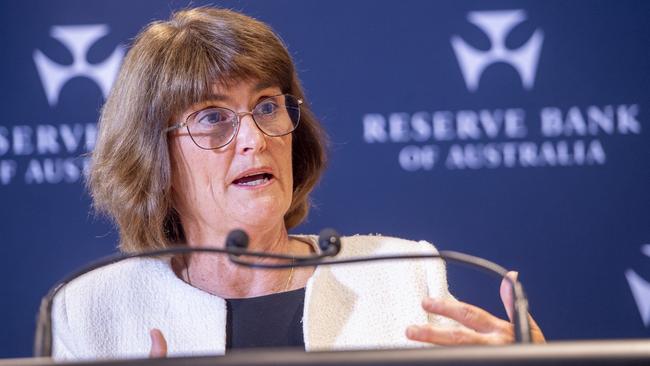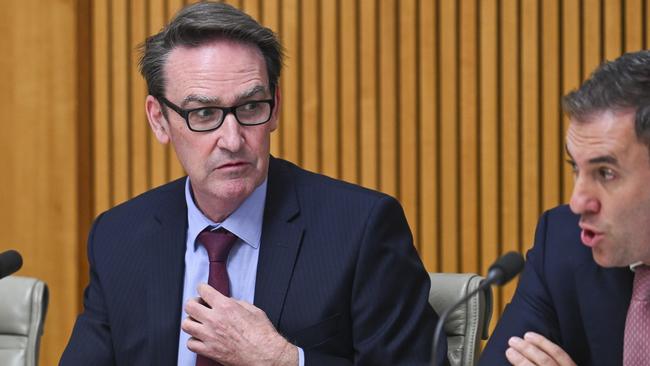
I do not deny the importance of interest rate relief for mortgage holders.
Nor am I ignoring the obvious political stakes riding on this meeting.
But let’s be real here: a slight reduction in mortgage repayments cannot begin to undo the cumulative economic harm the Albanese government has inflicted on the community – or hoodwink the electorate into forgetting it on polling day.
What’s at stake at this RBA board meeting – more than anything else – is the reputation of our central bank and its governor.
This is not the first interest rate decision that will take place during an election campaign, nor will it be the last.
In fact, on the eve of the May 2022 poll the RBA board raised the cash rate, but the credibility of the RBA or its board did not come into question then.
So why is this meeting different?
As I wrote in these pages in December, over the past two years Jim Chalmers and Steven Kennedy, his Treasury secretary and personal confidant, have waged a determined campaign against the RBA and traditional central bank orthodoxy.
Chalmers commissioned a hostile review of the RBA, overhauled its top leadership and (in his formal agreement with the board) watered down its responsibility to keep inflation down.
This had the desired effect, with the RBA board under Bullock and Kennedy adopting a softly-softly strategy on inflation – capping the cash rate at 4.35 per cent while its peers in the US, Britain, Canada and New Zealand raised theirs into the 5s.
In the second half of last year and with an eye to the approaching election, Chalmers stepped up his efforts to get the cash rate lowered, claiming interest rates were “smashing the economy”.
Ross Garnaut and Craig Emerson – Labor-aligned economists and both very close to Kennedy – loudly and insistently supported this in the media.
This ugly and sustained public pressure put Bullock in an extraordinarily difficult position. To use one of her favourite phrases, she has had to tread a “narrow path”, balancing loyalty to her staff and policy principles on the one hand, and the need to avoid a public split with the Treasurer on the other.
Kennedy’s presence on the board – its second-most influential member apart from Bullock – has not made the governor’s life any easier. This is the background to Monday’s meeting that you will not see written up in the financial pages.

What about the meeting itself? Attention will focus on two basic points of difference between those urging a cash rate cut and those reluctant to take this step.
First, should the board be guided by headline inflation (which is now within the RBA’s 2-3 per cent target, due in part to the government’s cost-of-living subsidies) or underlying inflation (which remains above 3 per cent)?
While Kennedy and Emerson have argued that the former is the better measure, the RBA prefers the latter since it strips out the distorting effect of subsidies.
I agree with the RBA’s view. If governments can subsidise their way to lower inflation, then why don’t they double down on this strategy, taking headline inflation rate even lower?
In any case, when the subsidies are removed later this year, headline inflation is expected to again move well above the target. The second contested issue is whether the labour market is too tight to justify a cut in the cash rate.
Emerson and Garnaut believe it isn’t, pointing to the relatively moderate nominal wage growth we have seen recently.
The RBA staff view is that it is. They believe the non-inflationary rate of unemployment is higher, perhaps as high as 4.5 per cent (but at least 4.25 per cent).
In other words, the labour market is running too hot at the moment to take off the interest rate brakes, despite supply-side constraints limiting economic growth.
I believe the Emerson view is mistaken here too. When labour productivity is going backwards, as ours has been in recent years, even modest nominal wage increases will be inflationary. In conventional economic terms, therefore, the case for a rate cut remains very weak. The board’s own test for cutting the cash rate – that inflation is sustainably returning to target – has not been met.

In the weeks since Donald Trump has taken office, global markets have been hit by a succession of shocks. Previous certainties and assumptions no longer apply. In an important development, the US Fed has dropped its earlier plans to cut rates this year. In an uncertain world, central banks making contested calls should opt for the least-worst alternative; the least costly error to make, assuming they are likely to err.
Two kinds of error suggest themselves. If Chalmers’s hoped-for rate cut proves premature and must later be reversed, our inflation problem will be worse and the credibility of the RBA will be in tatters. On the other hand, if the board errs in the other direction – by not cutting when, with the benefit of hindsight later this year, it becomes clear it should have done so – it can be corrected at far less cost to the bank’s reputation.
It didn’t have to be this way.
If Chalmers had not waged his wrecking campaign against the RBA, its board – like its predecessors – could well have gotten away with an election-eve cash rate cut with no reputational damage done. And if the board had in 2023 and early last year raised the cash rate higher than it did, there might be enough capacity in the economy to justify a cut now. At the RBA board meeting, Bullock is likely to face her moment of truth. Will she do the right thing for the Australian people or adopt the line of least political resistance?
David Pearl is a former Treasury assistant secretary.








The commentary in the lead-up to Monday’s RBA board meeting has focused on the political implications of the expected cash rate cut, but largely ignored what I think is a far more important question. Will this move deal a serious blow to the credibility of RBA governor Michele Bullock and the institution she leads?